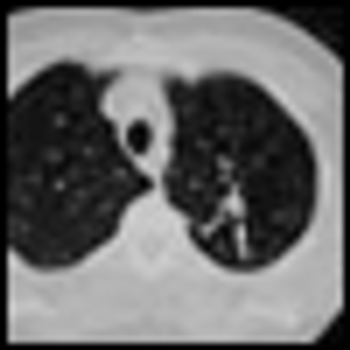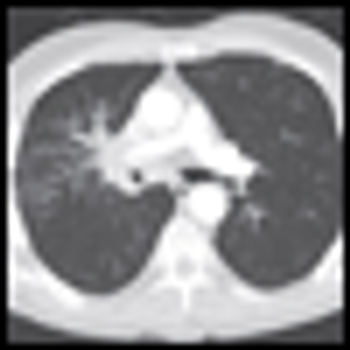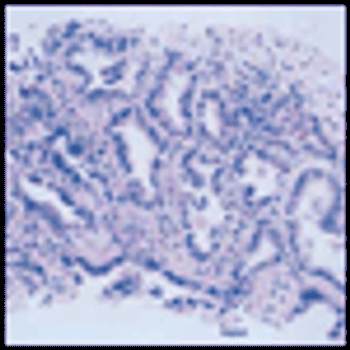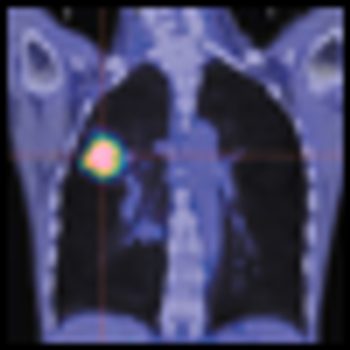
All trials are not equal, even those conducted by the NCI. It’s all about design, according to leading lung cancer specialist.

Your AI-Trained Oncology Knowledge Connection!


All trials are not equal, even those conducted by the NCI. It’s all about design, according to leading lung cancer specialist.

20% fewer lung cancer deaths seen among those who were screened with low-dose spiral CT than with chest X-ray

Research from Japan documenting remarkable survival rates among patients with inoperable lung cancer may only hint at the potential of proton beam therapy.

In these patients with substantial symptoms and short life expectancy, there's no reason to delay delivery of palliative care.

Ganti and colleagues have provided a brief review on the diagnosis of small-cell lung cancer (SCLC) and the roles of chemotherapy and surgery in its management. Notably, in the past three decades, the most significant progress in the treatment of SCLC has mainly involved the use of radiotherapy. Thus, to complement their assessment, we will provide an overview of the role of radiation in the management of limited-stage and extensive-stage SCLC.

Small-cell lung cancer (SCLC) is a pathologically distinct malignancy of the lung, characterized by rapid growth, propensity for early metastatic spread, and responsiveness to chemotherapy and radiation. Despite its generally good initial response, the relapse and subsequent mortality rate remain very high. Only 3% to 8% of all patients survive 5 years, and median survival for extensive stage disease is 8 to 13 months.[1,2]

The role of radiation therapy (RT) in lung cancer is long established; some of the earliest Radiation Therapy Oncology Group reports dealt with non-small cell lung cancer (NSCLC).[1,2] More recently, the advent of stereotactic body RT (SBRT) techniques has provided significant local control rates after focused treatment of selected small metastases and inoperable early stage lesions.[3,4] Our center has been in the forefront of examining SBRT and its role in central [5] or bilateral [6] lesions, its effect on PET imaging [7] and pulmonary function testing,[8] and subsequent frequency of brachial plexopathy,[9] chest wall toxicity,[10] or pneumonitis.[11] Still, even this highly conformal technique comes with potentially significant dose to adjacent normal tissue. This is in the context of an emerging appreciation for the pulmonary consequences of elevated mean lung dose,[12] or V5 after pneumonectomy.[13] For each lung cancer patient requiring RT, an effective mechanism to deliver dose to the tumor while minimizing dose to uninvolved lung is called for. Enter protons.

In the conclusion to the article “Proton Radiation Therapy for Lung Cancer: Is There Enough Evidence?” Dr. David Bush puts his finger on the critical issue underlying most debates about the value of new medical technologies. He notes that “The evidence required to bring new technology into clinical practice is poorly defined.”[1] In the specific context of this article, the answer to the question of whether or not there is enough evidence depends entirely on how one chooses to define “enough.” Some experts believe that biological modeling based on dose distributions is sufficient to conclude that proton therapy improves health outcomes. Others have argued that the evidence is only adequate once randomized clinical trials have been completed to directly compare alternative interventions. Whatever one’s position on this issue, the lack of clarity on the question of adequacy of evidence is a major contributor to the gaps in knowledge about the comparative effectiveness of many widely used clinical interventions. Accelerating the rate at which this knowledge is generated will require a serious and sustained effort to define these evidence thresholds. This would allow more energy to be channeled into generating the needed evidence and less energy to be devoted to debating whether or not the evidence we have today is good enough.

Just as in recent years attitudes and treatment therapies have changed regarding non–small-cell lung cancer (NSCLC), it is time that the same occur for its small-cell counterpart. Although treatment for advanced-stage small-cell lung cancer (SCLC) is fairly standardized, there remain a number of controversies that have yet to be clarified by evidence-based data.

Proton radiation for cancer offers the ability to conform the high-dose region of radiation therapy to the tumor while reducing the dose of radiation to adjacent normal tissues. In lung cancer, this equates to greater sparing of uninvolved lung, heart, esophagus, and spinal cord. Sparing these normal tissues permits the delivery of higher-radiation doses to the tumor. Studies that compare the distribution of radiation doses for lung cancer show that proton radiation is superior, even when factors such as respiratory motion are considered. Clinical experience confirms the feasibility of proton radiation for early-stage non-small-cell lung cancers, and clinical trials are being conducted in locally advanced tumors: To date, evidence indicates that proton radiation should be further explored.

Despite a decreasing incidence in the United States, small-cell lung cancer (SCLC) remains a major clinical problem, with approximately 30,000 new cases each year. The diagnosis of SCLC is usually not difficult. The Veterans Administration Lung Study Group (VALSG) staging system is less accurate than the American Joint Committee of Cancer tumor-node-metastasis (TNM) system (7th edition) at predicting survival in SCLC, especially in lower stage disease. Surgery has not played a major part in the management of SCLC, but emerging data suggest that resection may have a role in earlier stage disease. While the frontline treatment of SCLC has not changed significantly in the past decade, newer agents that are currently being investigated provide hope for better treatment of relapsed/refractory disease for the future.

Bronchioloalveolar carcinoma (BAC) is a unique subtype of lung adenocarcinoma that has received increasing attention in recent years. Levy and colleagues have provided a comprehensive review of the clinical and pathologic characteristics of this disease, as well as the clinical evidence available to guide treatment of patients with BAC.

In this issue of Oncology, Levy and colleagues provide a comprehensive review of bronchioloalveolar carcinoma [BAC], with a focus on the management of this rare disease, which represents 4% of all lung cancers.[1] The definition of BAC was revised by the World Health Organization (WHO) in 2004, with changes made to the diagnostic criteria and classification.[2] BAC was defined as an adenocarcinoma of the lung that grows in a lepidic fashion along the alveolar septa without invasion of stroma, blood vessels, or pleura. BAC has been sub-classified into three types: nonmucinous, mucinous, and mixed.

Bronchioloalveolar carcinoma (BAC) is a subset of pulmonary adenocarcinoma characterized by distinct and unique pathological, molecular, radiographic, and clinical features. While the incidence of pure BAC is rare, comprising only 1% to 4% of non–small-cell lung cancer (NSCLC), mixed subtypes (including BAC with focal invasion and adenocarcinoma with BAC features) represent as much as 20% of adenocarcinomas-and that figure may be increasing. Despite the longstanding recognition of this entity, there is no established treatment paradigm for patients with multifocal BAC, resulting in competing approaches and treatment controversies. Current options for multifocal BAC include both surgery and systemic therapies. Unfortunately, prospective data on systemic approaches are limited by study design and small patient numbers; there are only seven phase II studies involving four therapies. This article evaluates key characteristics of BAC, including the current understanding of histopathology and tumor biology. In addition, it comprehensively reviews the systemic phase II studies in an attempt to clarify the therapeutic challenges in this disease. It also includes the first proposed treatment paradigm that integrates both EGFR mutational status and the sub-histologies, mucinous and nonmucinous BAC.

It's been a mere 8 years since the blurry spots called ground glass opacities GGOs that appeared on spiral CTs were first linked to cancer. Already, the first hints are emerging of what they may actually mean to malignant transformation.

Data from French trial should inform treatment decisions in the majority of lung cancer patients aged 70 and up.

Results of a long-term intergroup study on the effect of selenium in early non-small-cell lung cancer highlight the differences between smokers and nonsmokers, and support the thesis that “good” supplements may be harmful in the presence of carcinogens.

The Eleventh Lung Cancer Congress will be held July 8-11, 2010 in Rancho Palos Verdes, California

Metformin, a biguanide antidiabetic drug administered orally, could play a critical role in controlling, and possibly preventing, lung cancer in at-risk patients. Animal studies conducted at NCI demonstrated that treating mice with metformin reduced lung tumor volume by about 50%.

Lung cancer is not a discriminate disease, but the disease burden is especially high on African Americans in the U.S. The statistics are stark: African-American men are 37% more likely to develop lung cancer than white men and are 22% more likely to die of it. In addition, only 12% of African Americans live longer than five years after a diagnosis of lung cancer, compared with 16% of whites, according to a recent report by the American Lung Association.

Success of adaptive randomization in BATTLE could provide new strategy in cancer trials. NSCLC also gain another tool for maintenance therapy.

Results of a new study published in the Annals of Internal Medicine [Ann Intern Med 152:505-512, 2010] indicate that the risk for false-positive results of CT lung cancer screening tests is substantial. Led by Jennifer M. Croswell, MD, researchers from NCI sought to quantify the cumulative risk in a 1- or 2-year lung cancer screening exam, based on at least one false-positive finding.

Tyrosine kinase inhibitors (TKIs) targeting the epidermal growth factor receptor (EGFR), such as erlotinib (Tarceva) and gefitinib (Iressa), have shown remarkable activity in a portion of patients with non–small-cell lung cancer (NSCLC).

It is estimated that more than 1.5 million individuals in the United States will be diagnosed with cancer this year. Of these, nearly 145,000 will be diagnosed with non–small-cell lung cancer (NSCLC).

The review by Oxnard and Miller provides a thoughtful update on the use of the epidermal growth factor receptor (EGFR) tyrosine kinase inhibitors (TKIs) gefitinib (Iressa) and erlotinib (Tarceva) as front-line therapy in patients with non–small-cell lung cancer (NSCLC).